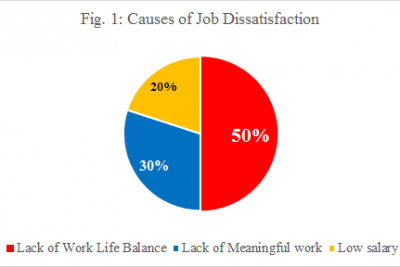Seems strange, isn’t it?
Despite strong evidence which points that the per capita income of India based on current prices have increased from Rs 20,000 in 2000 to approx. Rs 87000 in 2015 (a 4.5-time increase in 20 years) [Source: Click here] , the job satisfaction has plummeted to a dismal 40% level only.
80% of the workforce thinks seriously about quitting their current jobs [Source: Click here]
How can the Fastest growing economy of the World face such a problem? Clearly, money is not the only force which drives dissatisfaction.
The dissatisfaction levels are spread out across different work levels, be it senior level, middle level or junior level employees. No wonder, such a high level of dissatisfaction takes a toll on the productivity level of our workforce, and frequent attrition or employee turnover causes economic loss to the Company. The loss is not just limited to economic loss.
Studies have also shown that job related dissatisfaction causes increased levels of stress in the affected employees, which can manifest into several psychosomatic problems like acidity, back pain, stiffness in neck and shoulders, forgetfulness, anger, and worry, significantly increased in people having higher stress scores.
One can clearly imagine the loss of labour as well as the compounded economic loss to the Country as a whole due to such a problem.
India is slated to have the youngest workforce by 2020 with an average age of just 29 years [Source: Click here]. If such a major problem lingers around, then the huge potential demographic dividend could be lost forever to health-related issues and result in loss of productivity to a massive scale.
On examining the root causes of job (dis) satisfaction, it was found that a whopping 50% of the people found the lack of work-life balance to be the most significant contributor towards job dissatisfaction. Only 20% complained about low salary. [Source: Click here] (See Fig. 1)

Clearly, lack of work-life balance is a major culprit contributing to employee dissatisfaction and not salary figures.
Let us think about this carefully.
About 50% of the workforce is going to be comprised of millennials. [Source: Click here]
They are the key to solving the problem of job dissatisfaction, and their needs are quite strikingly different from that of the preceding generations. This schism can lead to job dissatisfaction.
Role of the Organisation
Let us analyse the duties of the Organisation as well as its young and budding workforce to solve such a problem and let India reap the benefits of the huge demographic dividend.
- Work Life Balance: Organisations need to shed the archaic mentality of work life balance being counterproductive. Instead, the organisations should think logically based on the available data, that they can avoid potential economic losses to the organisation by offering proper work life balance to employees. When Companies calculate operational efficiency and implement cost cutting measures, they often fail to consider the human element behind the entire scene. Now work life balance is a balancing act, like regular 8 hour working day, 5 days a week. It doesn’t mean constant vacationing. Several countries like Germany, Sweden have taken steps towards this regard. India should also take steps to match the global best practices.
- Meaningful work: Work with a definite purpose. Millennials evaluate the quality of work favourably if they find their contribution fitting in the bigger canvas of the organisation. For this, the organisation needs to regularly communicate with the employees and give them leadership responsibilities, train them, rectify their initial mistakes and encourage them to work in a correct manner. The job of the Manager should be equivalent to that of a mentor, coach or guide and not of a bureaucrat. More involvement, regular communication and feedback are the key to building an effective team
- Removing Technological Barriers: Millennials want to be connected to Social Networks, be it Facebook, Twitter or Instagram. Blocking access to such sites in the office systems can alienate such millennials. At the same time, too much addiction is also a loss for the Company. To resolve this, the company can adopt either of the two approaches. First, they can limit access to Social Media during designated time for tea or snacks breaks, for around 30 minutes per day. Or they can block access to only those employees who do not deliver the results as agreed. Both the organisation, as well as the employees can reap benefits and contribute to the betterment of both the parties.
These are some of the ways by which we can think of solving the problem of job dissatisfaction and increase productivity for the Company and Country in general. In terms of a general saying referring to “kids these days”, the organisations should understand that
“kids these days are not after instant rewards or truck loads of cash for being present on time, but they are after meaningful work, mentoring, responsibility and a work life balance”.
Role of the Millennials
There are certain roles for the millennials to play, in order to create a collaborative work atmosphere with positive synergies, which can give benefits to the Organisation as well as the employees, some of which are:
- Courtesy and Respect: One should understand that he or she should always show respect to fellow employees to gain their trust and respect in turn. Over zealousness and impatience which some young professionals may end up resorting to, can be counter productive. They should listen to feedback in a positive manner and work hard to perfect over their mistakes and learn from them.
- Punctuality and Quality: No organisation will tolerate lateness or delay in work, under any circumstance. While a good work life balance and meaningful work are always desirable, the same should not become an excuse for late work or work without quality.
- Reverse Mentoring: There are some skills which can be learnt from senior people at work, like the technicalities of work themselves. There are also some skills which younger people can teach, like technological advancements in workplace. While seeking learning opportunity from seniors, the younger millennials should also collaborate with the seniors and teach them necessary skills like Social Network, advanced software, etc., so that effective learning throughout the organisation can be carried out, thereby saving costs for the organisation through learning curve effects.



